Data segmentation means to take ‘data’ (e.g. a group of people you want to contact) and split it into smaller groups based on your chosen criteria. Here, we explore ‘behaviour-based’ segmentation, and how it helps you create content that’s personalised to your customers.

How to segment your contacts
Think about how you can split you group of customer into smaller categories, and the types of behaviours or interests that make them different. A category can be as simple as purchase history, splitting up your list of customers based on when they last purchased.
The end goal is to split a big group of customers into smaller groups, and adjust the messaging you send to them based on those distinctions – that way, your content is becoming more personalised to those pots of people. Take the example below.
Example: Using purchase history to split contacts
Here’s an example of behaviour-based segmentation.
A retail brand is experimenting with splitting their contacts based on when they last purchased. The criteria is simple; they split the contacts into three groups:
- Customers who have purchased in the last month
- Customers who purchased >1 month ago
- Customers who haven’t purchased in >6 months
They get this information by cross-referencing contacts’ mobile numbers with their e-commerce system, and then creating these individual lists.
What next? They start to write their content for each group of people.
Using segments to create your content
Once you’ve established your categories, here’s when you can start creating the personalised content. For example:
Customers who have purchased in the last month
These are customers are the most engaged as they’ve recently purchased. There might be an opportunity here to send a follow-up message to ask for product feedback.
Hey Jules, we hope you love your new jacket!
Care to share how you feel about it? Please reply REVIEW followed by your feedback and I’ll give you a special gift to say thanks!
Love Lauren from Cords x
Customers who purchased >1 month ago
It’s time to remind them of your brand & show that personality! Perhaps a personalised product recommendation to compliment their recent purchase – and a chance to share your expertise.
Hey Jules, Lauren from Cords here. Hope you’re loving your new jacket!
We’ve crafted a scarf that perfectly matches. Together, they create the perfect autumn combo. It’s already been hailed ‘the most stylish scarf since scarves began’. Shop the scarf here…
Customers who haven’t purchased in >6 months
If it’s been a while since your customer has returned, why not address this in the message? It’s the perfect opportunity to provide an incentive to create an easy entrance back into your awesome brand.
Hey Jules, it’s Sally from Cords here.
I hope you’re okay – just wanted to personally reach out & say we miss you!
To welcome you back with open arms, here’s a little Friday treat from me to you. Use code MISSU2 at checkout for 20% off your next purchase with us. Visit the website here…
Segmenting as you go
Sometimes it can be hard to get that information, which we totally understand. So there’s also the option to ‘segment as you go’.
Generate segmented leads
You can generate leads with segmentation in mind. For example, if you want to create a ‘VIP subscriber’ contact list to get in touch with regularly, you can encourage your website visitors to subscribe using a pop-up or form.

You can also subscribe to SMS keywords to send out an initial message and segment your contacts from the first message you send. Like the example below.

Use FireText’s track URL
The track URL allows you to short and track a URL in your message. It also means that after every campaign you send, you can see a click report of all the recipients that did and didn’t click your messages.
Why does this allow you to segment? Because you can split the group into two: those who clicked and those who didn’t. The clickers were engaged, the non-clickers weren’t – so think about this and create two new follow-up messages that have this in mind. Again, you’re writing your messages around your contacts based on their behaviours – which is awesome!
